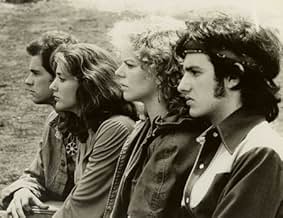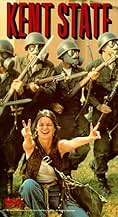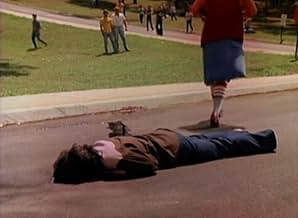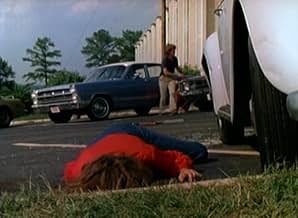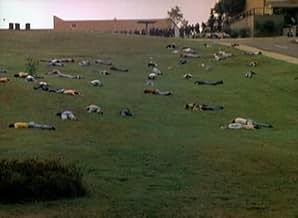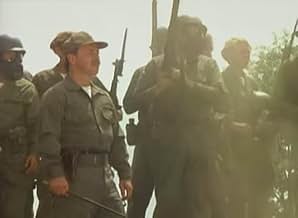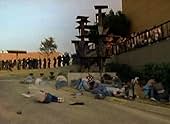PUNTUACIÓN EN IMDb
7,3/10
253
TU PUNTUACIÓN
4 estudiantes murieron cuando la Guardia Nacional intentó sofocar los disturbios que comenzaron el 4 de mayo de 1970, después de que el Presidente Nixon anunciara que las tropas estadouniden... Leer todo4 estudiantes murieron cuando la Guardia Nacional intentó sofocar los disturbios que comenzaron el 4 de mayo de 1970, después de que el Presidente Nixon anunciara que las tropas estadounidenses comenzarían a bombardear Camboya.4 estudiantes murieron cuando la Guardia Nacional intentó sofocar los disturbios que comenzaron el 4 de mayo de 1970, después de que el Presidente Nixon anunciara que las tropas estadounidenses comenzarían a bombardear Camboya.
- Dirección
- Guión
- Reparto principal
- Ganó 1 premio Primetime Emmy
- 1 premio y 1 nominación en total
Talia Balsam
- Sandy Scheuer
- (as Talia Baslsam)
Frederikke Borge
- Student
- (as Rikke Borge)
Ann Gillespie
- Sharon
- (as Anne Gillespie)
Peter Miner
- Robbie
- (as Peter Minor)
David VandeBrake
- Chip
- (as David Vande Brake)
Reseñas destacadas
Your telling me that the National Guard who had rifles with bayonets, bullets and tear gas, felt threatened by kids running and maybe throwing rocks felt threatened by these kids! I'm sorry I don't buy it any all. Some of those guardsmen could not wait to fire on those kids! They joined the guard to keep from going to Viet man but at the same time wanted to see some "action". Sickening.
A terrific television movie that deserved the Emmy the director received for best director of the year. Spellbinding and wonderfully acted by a young cast of unknowns, this movie takes us back to 1971 and the impact the Vietnam war was having on college campuses across the country. The war is raging on and many students have had enough of it and are leading protests across college campus. We follow the lives of the 4 students that are killed on the campus on that fateful day of May 4, 1971. The irony of the film is that none of the 4 were radical students and they just happened to be in the wrong place at the wrong time that day. We also follow the days leading up to the tragedy through the eyes of the professors, politicians, police and young ROTC men. This should be a must see film for high school students studying the Vietnam war as the deaths of the 4 students and many wounded turned the tide of public opinion against the war in America.
The movie shows the events at Kent State Univeristy between April 30th 1970, when Nixon announced his plans to invade Cambodia, and May 4th, when the National Guard killed 4 students, and wounded several others. Beware
. This is not a documentary, no 100 % true account of what actually happened. This is clearly acknowledged by the filmmakers at the end of the movie.
Just to give one example, I haven't made a deep study of it, but most of the photo's I've seen from the actual protesting students show youngsters with less Easy Rider-looks than those depicted in the movie. It even seems to have been somewhat a surprise that these tragic killings happened in Kent, as this University had a rather slightly "conservative" reputation.
On the positive side, I'd like to underline that this movie is really doing its best to show things from different perspectives. There's room for the student's point of view,but also for that of the Guardsmen, the university staff...
To begin with, not all students were happy with what was taking place, and a certain percentage therefor wasn't protesting, just went on going to the classes. Those who were protesting, didn't seem to care very much for strong debates about international politics. There's not much healthy discussions going on about peace versus Real Politik, or about who could be a good replacement for "dear Henry". I have the impression that f. ex. French students were having much more heated philosophical and political debates. In Kent, it seems most students just repeated somewhat hollow slogans (What do we want ? Peace ! When do we want it ? Now !). They were therefor rather protesting with their heart than relying on good arguments and alternatives. A black student sees the protests against the war and military service as something purely "white",showing there even was a racial side to the protests.
On the other hand, the movie also makes a balanced portrait of the Guardmen. Some try to be friendly towards the students, talking with them, even wearing a flower in their rifle, or romancing. We learn that some of them had no experienced at all, and they look somewhat bewildered, finding themselves in a campus. Most of the Guardsmen are terribly tired, because of earlier confrontations with Teamsters. Only a small number seem to be nasty little sadists, but they aren't very popular within the NG itself.
It will probably remain unclear, whether the Nixon administration was somehow involved in discrediting the student movement. When the ROTC building is set afire, some students are wondering aloud who these guys with their torches are, suggesting they were not known to them. And when the unpopular military wooden building is starting to burn, only a few seem to be singing "Come on baby light my fire". Others shake their head in disbelief, as this act of vandalism seems to be a step too far for them. The movie also shows the differences between the staff members of the University. Some authors suggest that about 10 Guardsmen seem to have been targeting specifically certain students. Historians and researchers haven't come up with absolute proof to make this claim stick. And until now, none of the Guardsmen have been convicted for the death or the wounding of students.
To this European reviewer, this movie therefor seems to do its utmost to give a balanced picture of the events. Not all students are portrayed as crypto-communists, as the Nixon administration depicted them to a shocked public opinion. At the same time, the movie clearly shows the National Guard too wasn't a fascist monolith, as some students seemed to think. To be able to come up with a balanced portrait, the movie makers created a number of fictitious characters. Therefor it is no longer a 100 % true account of the events. For those who prefer the true facts, there are several (good) books available. I have begun reading "The truth about Kent State" by Peter Davies for example.
Many Americans who see themselves as "True patriots" still don't find today -with hindsight- reasons to have at least some sympathy for the 1960's / '70's student's movement. However, maybe they will appreciate how this movie shows the difficult situation in which the NG found itself at the campus. Anyway, whatever one's point of view, it's definitely ALWAYS a sad fact when young people lose their life or get seriously wounded, for whatever reason. Made 10 years after the facts, this relatively prudent movie apparently still couldn't convince many Americans about the solidity of this statement.
Just to give one example, I haven't made a deep study of it, but most of the photo's I've seen from the actual protesting students show youngsters with less Easy Rider-looks than those depicted in the movie. It even seems to have been somewhat a surprise that these tragic killings happened in Kent, as this University had a rather slightly "conservative" reputation.
On the positive side, I'd like to underline that this movie is really doing its best to show things from different perspectives. There's room for the student's point of view,but also for that of the Guardsmen, the university staff...
To begin with, not all students were happy with what was taking place, and a certain percentage therefor wasn't protesting, just went on going to the classes. Those who were protesting, didn't seem to care very much for strong debates about international politics. There's not much healthy discussions going on about peace versus Real Politik, or about who could be a good replacement for "dear Henry". I have the impression that f. ex. French students were having much more heated philosophical and political debates. In Kent, it seems most students just repeated somewhat hollow slogans (What do we want ? Peace ! When do we want it ? Now !). They were therefor rather protesting with their heart than relying on good arguments and alternatives. A black student sees the protests against the war and military service as something purely "white",showing there even was a racial side to the protests.
On the other hand, the movie also makes a balanced portrait of the Guardmen. Some try to be friendly towards the students, talking with them, even wearing a flower in their rifle, or romancing. We learn that some of them had no experienced at all, and they look somewhat bewildered, finding themselves in a campus. Most of the Guardsmen are terribly tired, because of earlier confrontations with Teamsters. Only a small number seem to be nasty little sadists, but they aren't very popular within the NG itself.
It will probably remain unclear, whether the Nixon administration was somehow involved in discrediting the student movement. When the ROTC building is set afire, some students are wondering aloud who these guys with their torches are, suggesting they were not known to them. And when the unpopular military wooden building is starting to burn, only a few seem to be singing "Come on baby light my fire". Others shake their head in disbelief, as this act of vandalism seems to be a step too far for them. The movie also shows the differences between the staff members of the University. Some authors suggest that about 10 Guardsmen seem to have been targeting specifically certain students. Historians and researchers haven't come up with absolute proof to make this claim stick. And until now, none of the Guardsmen have been convicted for the death or the wounding of students.
To this European reviewer, this movie therefor seems to do its utmost to give a balanced picture of the events. Not all students are portrayed as crypto-communists, as the Nixon administration depicted them to a shocked public opinion. At the same time, the movie clearly shows the National Guard too wasn't a fascist monolith, as some students seemed to think. To be able to come up with a balanced portrait, the movie makers created a number of fictitious characters. Therefor it is no longer a 100 % true account of the events. For those who prefer the true facts, there are several (good) books available. I have begun reading "The truth about Kent State" by Peter Davies for example.
Many Americans who see themselves as "True patriots" still don't find today -with hindsight- reasons to have at least some sympathy for the 1960's / '70's student's movement. However, maybe they will appreciate how this movie shows the difficult situation in which the NG found itself at the campus. Anyway, whatever one's point of view, it's definitely ALWAYS a sad fact when young people lose their life or get seriously wounded, for whatever reason. Made 10 years after the facts, this relatively prudent movie apparently still couldn't convince many Americans about the solidity of this statement.
This is a very balanced portrayal and demonstrates the failures on all sides of the event. Yes, those shot and killed were innocent youth, some whom just happened to be at the wrong place at the wrong time. Yes, the SDS was on campus encouraging widespread unrest and violence. Yes, most of the National Guard troops were exhausted kids put in an impossible situation with live ammunition. Yes, the politicians involved were inept boobs who had no clue as to the right way to manage the situation and took actions to violate the students' constitution rights. The only major miss here was they show the burning of the ROTC building but leave out much of the other destruction caused to the city of Kent, which was a key factor in the level of tension in the community and led to extreme reactive actions on all sides.
This movie should be required viewing of every student (and some adults) in America. That would help to remind the entire country of its history. The lack of comments about this movie testify to the fact that this incident has been all but forgotten in a country that is so vocal about Tiananmen Square.
¿Sabías que...?
- CuriosidadesThe administration at the real Kent State University would not allow the movie to be filmed on their campus. Gadsden State Junior College in Alabama was chosen because of its remarkable similarity (at the time) to Kent State University.
- Versiones alternativasOriginally released at 180 minutes long, some video versions run as short as 120.
- ConexionesFeatured in The 33rd Annual Primetime Emmy Awards (1981)
Selecciones populares
Inicia sesión para calificar y añadir a tu lista para recibir recomendaciones personalizadas
Detalles
- Fecha de lanzamiento
- País de origen
- Idioma
- Títulos en diferentes países
- Kent State
- Localizaciones del rodaje
- Alabama Technical College, East Broad Street, Gadsden, Alabama, Estados Unidos(Off Campus Bookstore Exterior)
- Empresas productoras
- Ver más compañías en los créditos en IMDbPro
Contribuir a esta página
Sugerir un cambio o añadir el contenido que falta

